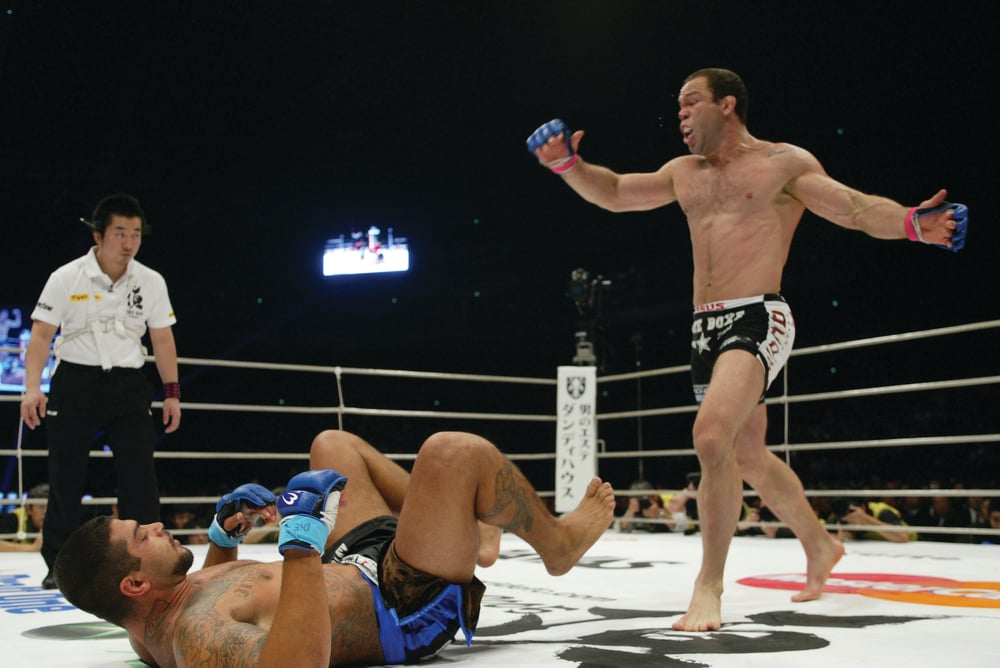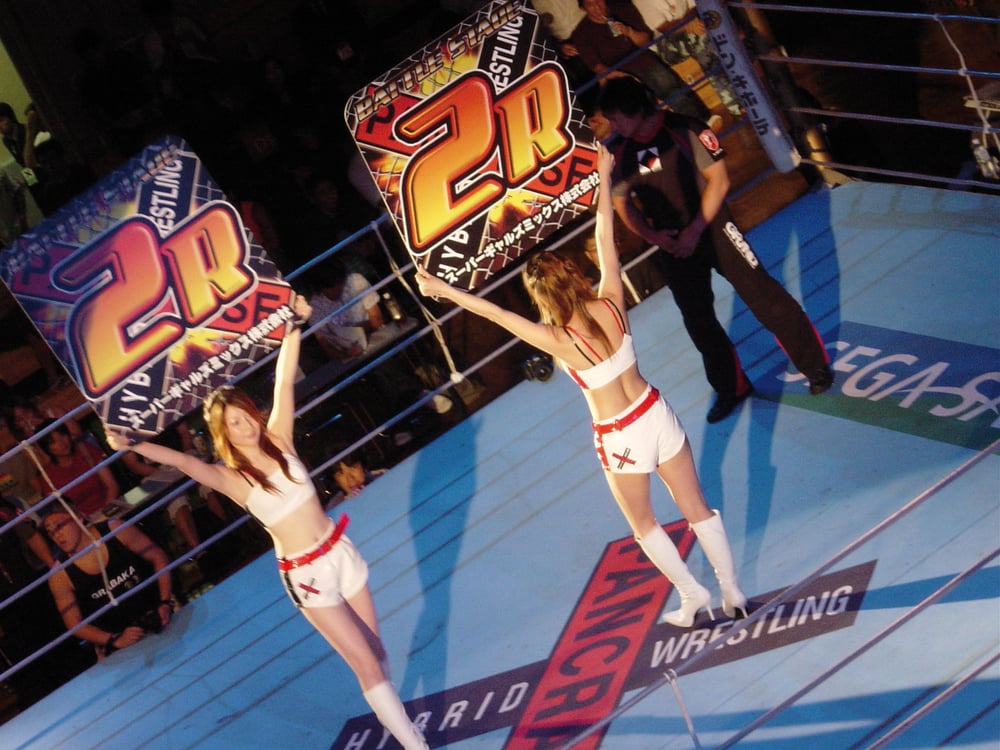
Issue 016
August 2006
By Andrew Garvey
Mixed martial arts in Japan initially grew from pro wrestling (known as ‘Puroresu’), traditional martial arts and the influence and fame of the Gracie family. MMA in Japan retains close links to the Puroresu world- indeed for many Japanese, MMA is really a logical extension of traditional Puroresu.
The showbiz aspects remain, only now the fights are for real. Japanese MMA has never experienced the kind of negative publicity that has dogged the sport in Europe and North America. The big MMA events on New Year’s Eve is a firmly established tradition and is the biggest night of the year for TV viewership in Japan. It is also the biggest night of the year for MMA, with K-1 and Pride competing for those all-important TV ratings.
Japan boasts more than just the two big shows though, and there are many smaller companies that often act as ‘feeder’ groups to the major promotions. Together they comprise the biggest and most mainstream MMA scene on the planet. Here is a brief look at the major, and some of the not so major, players in the Land of the Rising Sun.

PRIDE FC
Originally formed in 1997 to promote a dream match between pro wrestler Nobuhiko Takada and Rickson Gracie, PRIDE has grown into the biggest MMA promotion in the world. Practically monopolising the sport’s top heavyweight talent, PRIDE has promoted some of the sport’s most legendary matches. With Gracie destroying Takada and repeating the trick a year later, only the emergence of Kazushi Sakuraba saved the big-spending promotion from financial ruin. His success in legendary matches with various members of the Gracie family (for one example see this month’s Classic Fight on page 76) brought in enormous amounts of cash and press attention, as did his three matches with Wanderlei Silva. The elusive Sakuraba-Rickson blockbuster never happened (at least in PRIDE) but he provided the launch pad for an incredible success story.

Picking up marketable talent from the UFC, poaching big names from the dying promotion RINGS (like Antonio Rodrigo Noguiera and Fedor Emelianenko), employing big name pro wrestlers and enticing Olympians into fights, PRIDE built a business on quality fighters and genuinely mainstream matches. Famous for their mega-budget supershows, routinely selling up to and beyond 35,000 tickets to major shows, PRIDE started branching out in 2003. The Bushido series, meant to showcase lighter weight fighters, was a flop at first but really picked up in 2005 and it has provided some incredible action from some of the world’s very best fighters. PRIDE’s current roster of champions Fedor Emelianenko, Wanderlei Silva, Dan Henderson and Takanori Gomi is the most impressive in the entire sport of MMA and PRIDE have promoted immensely successful tournaments in the years 2000, 2003, 2004, and 2005. Currently midway through an openweight Grand Prix and a welterweight Grand Prix, they will in fact run a total of three tournaments this year.

K-1 HERO’s
Just as K-1 MAX has been for years, HERO’s is built mostly around the smaller fighters and is marketed to teenagers and women. The HERO’s MMA brand pulled in some great TV ratings after being formed in early 2005. K-1 as a whole has been dabbling in MMA for a few years, featuring the odd fight here and there since 1994. Featuring high-level production values (that often surpass even PRIDE’s) and mid-week primetime TV specials, HERO’s put on quite a show. But they are more than just an eye-catching company with pretty light shows and graphics. HERO’s events have showcased some of Japan’s best and most marketable talent in the form of the charismatic and controversial Norifumi ‘Kid’ Yamamoto (their 154 pound champion), the entertaining Genki Sudo and the very capable Caol Uno.
The emphasis is on fast-paced action and fights are over 2 x 5 minute rounds, with an extra session if the judges call the fight a draw. HERO’s also has access to major names from K-1, with Peter Aerts and Jerome LeBanner both appearing in MMA action. Looking to expand into other weight divisions, HERO’s have major tournaments at 154 pounds and 185 pounds this year. The latter will involve BJ Penn and their recent prize acquisition Kazushi Sakuraba. Even without Pride’s current difficulties (see the news section for more details) 2006 looked set to be the year when HERO’s would challenge for the number one position in Japanese MMA.
Shooto
The oldest and most serious of Japanese promotions, Shooto is one of the most respected organisations in the world. Title shots are given according to merit and based on a strict rankings system. Shooto have working relationships and partner promotions all over the world, including the USA, Scandinavia and the former Soviet Union. A lighter weight fighter with a strong Shooto background is automatically respected for having emerged from such a competitive environment. Fighters are rarely thrown in at the deep end and instead are matched up according to experience and skill level in three different classes. Class C Shooto is for newcomers. With experience and victories they move up to Class B and the promotion’s top stars compete in Class A. Matches are fought over 2 or 3 x 5 minute rounds and Shooto particularly specialise in developing and promoting talented fighters 160lbs or under.
Most Shooto events take place in front of small crowds and the promotion’s home base is Tokyo’s Korakuen Hall (which seats less than 2000 people) and amazingly for a company with so much history, they have never drawn a crowd of more than around 10,000. Still, the company has produced some of the sport’s very best talent. Norifumi ‘Kid’ Yamamoto, Takanori Gomi and leading contenders like Tatsuya Kawajiri, Joachim Hansen and Hayato ‘Mach’ Sakurai are all former Shooto stars and some still occasionally fight on Shooto events.
Today, Shooto is home to some of Japan’s very best up and coming talent, and is usually the first place to look for the PRIDE and HERO’s superstars of tomorrow. A stable, well-run organisation, it promoted 22 shows last year, including their all-female G-Shooto event. Shooto will never be the country’s biggest MMA group but it is absolutely vital to the scene’s long-term growth.
Pancrase
Named after the ancient Olympic sport of Pankration, Pancrase have an incredibly influential past behind them but a very tough future ahead. The second-oldest regular MMA promotion in the world, Pancrase debuted two months before UFC 1. Pancrase has changed considerably over the years. Headed by a trio of young pro wrestlers who wanted to fight for real (Masakatsu Funaki, Minoru Suzuki and Ken Shamrock), Pancrase was a huge hit. The glory years of 1993 to 1996 featured some incredible talent, most notably Bas Rutten and Frank Shamrock. Early Pancrase events had unique rules, which were derived from pro wrestling.
There were no closed fist attacks allowed to the head, striking on the ground was discouraged, there were no rounds and submission holds could be escaped by grabbing the ropes. With the rise of PRIDE and its spectacular events, big names and more permissive rules, Pancrase’s popularity began to fade. They switched to their current more standardised MMA rules in 1999 (essentially PRIDE rules, over 2 or 3 x 5minute rounds) but with the big names long gone or over the hill, they had no genuine stars left. Pancrase still run around 15 events a year in small arenas, but these days their profile and quality of their fighters has slipped well below that of Shooto. Their biggest star is light heavyweight champion Yuki Kondo, a man who fights mostly on PRIDE shows these days.
DEEP
With more of a pro wrestling flavour than any other Japanese promotion, DEEP have run shows featuring pro wrestling matches, and have even had masked Mexican wrestlers in real matches against Japanese fighters. Like most of Japan’s smaller MMA groups, DEEP is competing in a very crowded, difficult marketplace. Founded in 2001, DEEP featured some big names like Royler Gracie and Ikuhisa Minowa on earlier events, but more recently have concentrated on promoting lesser known Japanese and Korean fighters, as well as bringing in fighters from the US and Europe. PRIDE fighters such as Ryo Chonan (the current DEEP Middleweight champion), Minowa and Ryuta Sakurai have appeared on recent shows, and these days DEEP is essentially a feeder promotion for PRIDE.
GCM
An oddity in Japanese MMA, GCM’s ‘DOG’ shows are held in an octagonal cage (the only promotion to do so in Japan). Like DEEP and other smaller promotions, GCM rely more on trying to make exciting fights between up-and-comers than risking everything on expensive big names. As with all the smaller groups, pay can be very low and the events mainly take place in smaller buildings. GCM (which bizarrely stands for Greatest Common Multiple) also hold submission events and have worked with K-1 on promoting ‘MARS’ shows in Japan, China and South Korea. GCM’s biggest name regulars include talented fighters like Yushin Okami, a man who looks ready to head to K-1 HERO’s, and Hidetaka Monma. GCM may be a low-profile company but they have some real talent, particularly on their flagship DOG shows (DOG stands for ‘Demolition of Octagon Gear’ for some reason). Look for more GCM talent on K-1 Hero’s shows in the future.
ZST
With rules very similar to the old RINGS promotion (there is restricted striking on the ground), ZST emphasise intense stand-up fighting and crazy submissions on the mat. With music playing in the background during fights (a concept stolen from Muay Thai) and the odd MMA Tag Team match (yes, really), ZST can be very unusual. The promotion generally features Japanese and Lithuanian talent, with fighters like Hideo Tokoro and Remigijus Morkevicius, both of whom have gained greater notoriety by also fighting for K-1 Hero’s.
Marcus Aurelio (who recently defeated Gomi in PRIDE) and CageWarriors featherweight champion Danny Batten have also fought in ZST. Founded in 2002 almost as a homage to RINGS (where ZST top star Naoyuki Kotani started his fighting career) they have put together some very exciting shows and tournaments, generally in front of small audiences, but have never run a show outside Tokyo. Smaller but much cooler and far more fun than Pancrase, ZST jostle for position with DEEP and GCM for fifth place in the country’s MMA pecking order.
...











